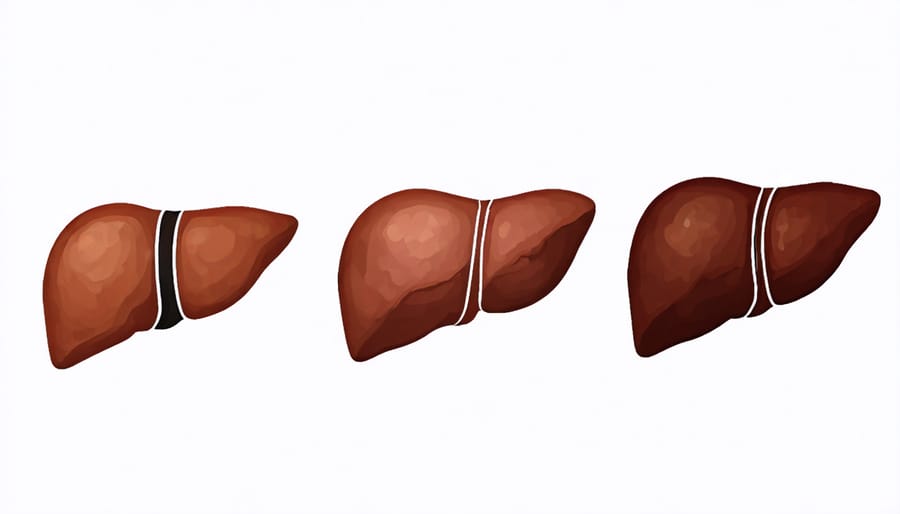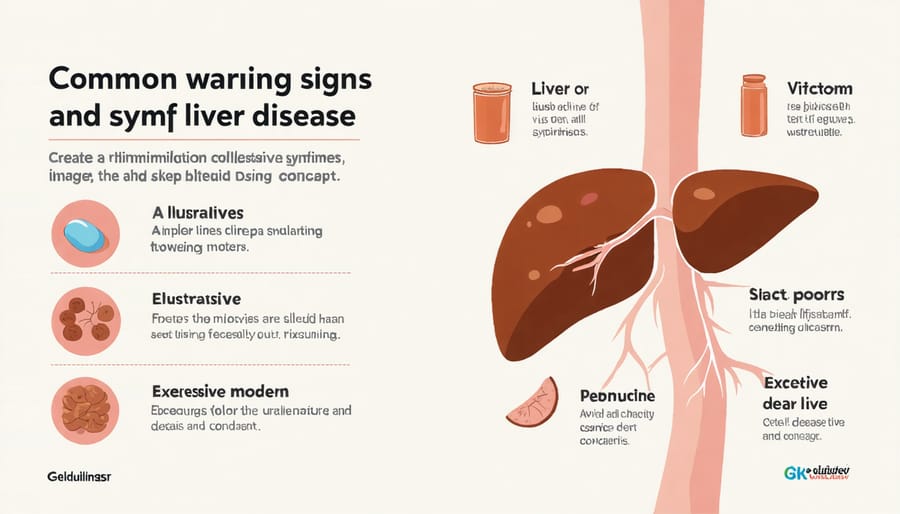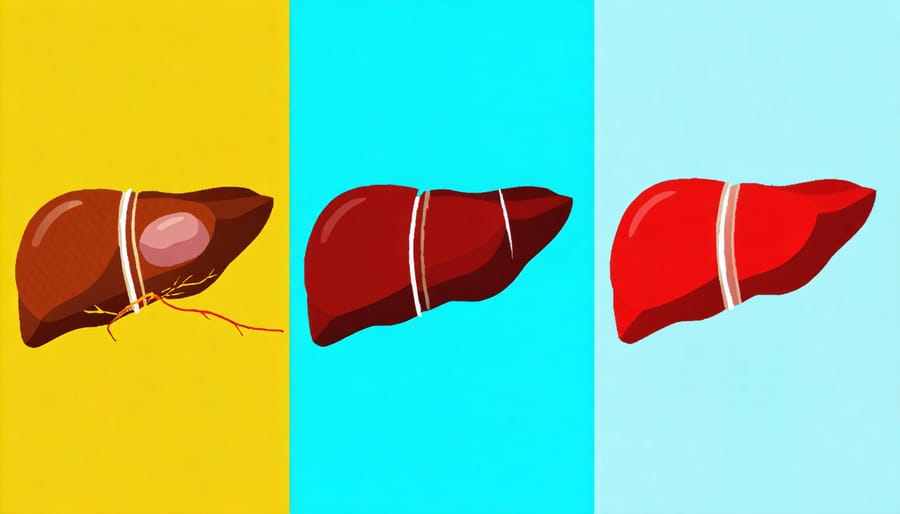Alcoholic liver disease silently affects thousands of Albertans each year, yet many don’t recognize its early warning signs until significant damage has occurred. This progressive condition, which develops from prolonged alcohol consumption, represents one of the most serious health challenges facing our community today. From fatty liver to cirrhosis, the disease spectrum ranges from mild to life-threatening, but early intervention can make a crucial difference. Understanding its impact, recognizing symptoms, and knowing when to seek help empowers individuals to take control of their health before serious complications arise. While complete prevention is possible through alcohol moderation or abstinence, even those already affected can significantly improve their outcomes with proper medical care and lifestyle changes. Our local healthcare system offers comprehensive support for individuals at any stage of this journey, making recovery and management achievable goals for every Albertan affected by this condition.
Understanding Alcoholic Liver Disease

The Three Stages of Liver Damage
Alcohol-related liver damage typically progresses through three distinct stages, and understanding these can help you recognize warning signs early. Let’s explore how your liver changes at each stage and what it means for your health.
The first stage is fatty liver, which occurs when fat builds up in your liver cells. Think of it as your liver becoming overwhelmed by alcohol and storing excess fat instead of processing it normally. The good news is that fatty liver is usually reversible if you stop drinking alcohol and make healthy lifestyle changes. Many people don’t experience symptoms at this stage, which is why regular check-ups are so important.
The second stage, alcoholic hepatitis, is more serious. Your liver becomes inflamed and damaged as it struggles to process alcohol. You might notice yellowing of your skin (jaundice), loss of appetite, nausea, and abdominal pain. This stage is still treatable, but recovery requires complete abstinence from alcohol and medical support.
Cirrhosis is the final and most severe stage. Here, healthy liver tissue is replaced by permanent scarring, making it difficult for your liver to function properly. Signs include severe fatigue, easy bruising, fluid build-up in your abdomen, and confusion. While cirrhosis isn’t reversible, stopping alcohol use can prevent further damage and help you manage symptoms more effectively.
The progression through these stages isn’t inevitable. Many Albertans have successfully prevented or halted liver damage by recognizing early warning signs and taking action. Your healthcare provider can help you assess your risk and develop a personalized plan to protect your liver health.
Remember, your liver has an amazing ability to heal itself, especially in the early stages. The sooner you address concerns about alcohol use and liver health, the better your chances of preventing serious complications.
Warning Signs You Shouldn’t Ignore
Recognizing the early warning signs of alcoholic liver disease can make a significant difference in treatment outcomes. While some symptoms might seem mild at first, it’s important not to dismiss them, especially if you regularly consume alcohol.
Pay attention if you experience unexplained fatigue that doesn’t improve with rest. This common early sign often gets mistaken for everyday tiredness but could signal your liver needs attention. Another early indicator is experiencing pain or discomfort in your upper right abdomen, where your liver is located.
Changes in your appearance can also signal liver problems. Watch for yellowing of your skin or the whites of your eyes (jaundice), which occurs when your liver isn’t properly processing waste products. Unexplained weight loss or frequent bruising might also indicate liver issues.
Here in Alberta, we often blame our dry climate for itchy skin, but persistent itching could be your liver sending warning signals. If you notice your ankles swelling or your belly becoming increasingly bloated, these could be signs of fluid retention related to liver problems.
Other warning signs include:
– Dark-colored urine
– Pale or clay-colored stools
– Loss of appetite
– Frequent nausea or vomiting
– Mental confusion or difficulty concentrating
If you experience any of these symptoms, especially if you drink alcohol regularly, don’t wait to seek medical help. Our Alberta healthcare system offers excellent support for liver disease management, and early intervention can prevent more serious complications. Remember, these symptoms might come and go, but that doesn’t mean the underlying issue has resolved itself.
Your family doctor can perform simple tests to check your liver function and provide guidance on next steps. They’re your best resource for addressing concerns about alcohol-related liver issues.

Risk Factors in the Alberta Context
Alberta faces unique challenges when it comes to alcohol-related diseases, with statistics showing higher rates of alcohol consumption compared to the national average. Recent data from Alberta Health Services indicates that nearly 1 in 5 Albertans exceed recommended drinking guidelines, putting them at increased risk for developing serious health conditions.
Our province’s distinct cultural and economic factors contribute to these statistics. The “work hard, play hard” mentality often associated with the resource sector, combined with higher average disposable income, can lead to increased alcohol consumption. Additionally, the stress of economic fluctuations and long winters may influence drinking patterns among Albertans.
Several modifiable risk factors specific to our region include:
– Higher rates of binge drinking among adults aged 25-45
– Greater accessibility to alcohol through privatized liquor stores
– Workplace cultures that may normalize heavy drinking
– Rural communities with limited access to support services
– High-stress occupations common in Alberta’s main industries
The good news is that awareness of these regional risk factors is growing, and Alberta Health Services offers numerous programs and resources specifically designed to help Albertans make healthier choices regarding alcohol consumption. Understanding these local factors is the first step toward making positive changes in our drinking habits and overall health.
Prevention and Lifestyle Changes
Safe Drinking Guidelines
Canada’s latest alcohol consumption guidelines recommend no more than 2 standard drinks per week to minimize health risks. For those choosing to drink, limiting intake to 1-2 drinks per occasion significantly reduces the risk of developing alcohol-related diseases. One standard drink equals 341 ml of beer (5% alcohol), 142 ml of wine (12% alcohol), or 43 ml of spirits (40% alcohol).
The safest approach is not drinking alcohol at all, especially if you have existing health conditions or take medications. If you do drink, spread your consumption throughout the week rather than having multiple drinks in one sitting. Remember to have alcohol-free days and never drink on an empty stomach.
Always consult your healthcare provider about how alcohol might affect your specific health situation, as individual risks can vary significantly.

Treatment Options and Support
Treatment for alcohol-related diseases in Alberta involves a comprehensive approach combining medical care and community support. The first step typically involves consulting your family doctor or visiting one of Alberta’s many addiction services centers. These facilities offer confidential assessments and personalized treatment plans.
Medical treatments may include medications to manage withdrawal symptoms, vitamins to address nutritional deficiencies, and specific treatments for liver complications. Alberta Health Services provides specialized liver clinics in major cities, offering advanced care for those with severe conditions.
Support groups play a crucial role in recovery. Organizations like Alcoholics Anonymous (AA) have numerous chapters across Alberta, offering free meetings and peer support. The Alberta Health Services Addiction Helpline (1-866-332-2322) provides 24/7 confidential support and can connect you with local resources.
For those managing your health condition, rehabilitation programs are available through both public and private facilities. These programs often combine medical treatment with counseling, lifestyle education, and family support services.
The Alberta Recovery Access Network helps coordinate treatment options, while organizations like AADAC (Alberta Alcohol and Drug Abuse Commission) offer outpatient counseling services. Remember, successful treatment often requires a combination of professional medical care, emotional support, and lifestyle changes. Your healthcare team can help create a treatment plan that works best for your specific situation.
Understanding and addressing alcohol-related diseases is crucial for maintaining long-term health and well-being. Throughout this article, we’ve explored how excessive alcohol consumption can lead to serious health conditions, particularly alcoholic liver disease, which affects many Albertans each year.
Remember, you’re not alone in this journey. Alberta offers numerous resources and support systems to help you make positive changes in your relationship with alcohol. Whether you’re concerned about your own drinking habits or those of a loved one, taking action now can prevent serious health complications later.
Start by speaking with your family doctor about your alcohol consumption and any concerns you may have. Consider joining local support groups or accessing addiction services through Alberta Health Services. Small changes, like setting drinking limits or having alcohol-free days, can make a significant difference in your health outcomes.
Your health is in your hands, and it’s never too late to make positive changes. By staying informed and taking proactive steps to moderate alcohol consumption, you can significantly reduce your risk of developing alcohol-related diseases and improve your overall quality of life.

